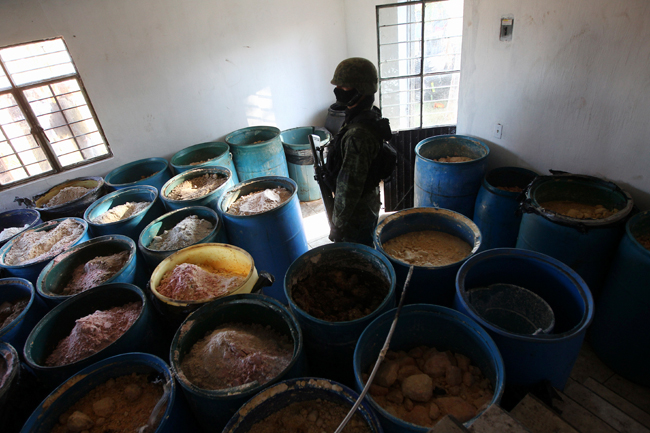GUADALAJARA, Mexico — The historic seizure of 15 tons of pure methamphetamine in western Mexico, equal to half of all meth seizures worldwide in 2009, feeds growing speculation that the country could become a world platform for meth production, not just a supplier to the United States.
The sheer size of the bust announced late Wednesday in Jalisco state suggests involvement of the powerful Sinaloa cartel, a major international trafficker of cocaine and marijuana that has moved into meth production and manufacturing on an industrial scale.
Army officials didn’t say what drug gangs could have been behind the dozens of blue barrels filled with powdered meth. Army Gen. Gilberto Hernandez Andreu said the meth was ready for packaging. There was no information on where the drugs were headed.
Jalisco has long been considered the hub of the Sinaloa cartel’s meth production and trafficking. Meanwhile, meth use is growing in the United States, already the world’s biggest market for illicit drugs.
The haul could have supplied 13 million doses worth over $4 billion on U.S. streets.
The Sinaloa cartel, headed by Joaquin “El Chapo” Guzman, is equipped to produce and distribute drugs “for the global village,” said Antonio Mazzitelli, the regional representative of the U.N. Office on Drugs and Crime.
“Such large-scale production could suggest an expansion … into Latin American and Asian markets,” Mazzitelli said. But he also noted, “it may be a product that hasn’t been able to be sold, and like any business, when the market is depressed, stockpiles build up.” A senior U.S. law enforcement official in Mexico said the operation raided in Jalisco was “probably Sinaloa.”
The official, who could not be quoted by name for security reasons, said Sinaloa may be trying “to reduce its reliance on Colombian cocaine by flooding the market with meth.”
Reporters were shown barrels of white and yellow powder that filled three rooms on a small ranch outside Guadalajara, Mexico’s second-largest city.
The lot around the house, which included an empty swimming pool, was littered with metal canisters and cauldrons used in the production process. While the equipment appeared makeshift and partially dismantled during a tour of the facility given to news media, it was apparently used intensively.
There were no people found on the ranch or arrests made, although it appeared 12 to 15 people worked there.
The seizure of such a large quantity of meth is expected to have a big impact on the U.S. meth market. A pound of meth can sell for about $15,000.
“This could potentially put a huge dent in the supply chain in the U.S,” said U.S. Drug Enforcement Administration spokesman Rusty Payne. “When we’re taking this much out of the supply chain, it’s a huge deal.”
But that may not ultimately mean less meth in the U.S. Law enforcement officials in California’s Central Valley, a hub of the U.S. methamphetamine distribution network, say a cutoff in the Mexican supply could mean domestic super labs will increase production.
“This will be a big seizure and will most likely slow down distribution for a short period of time until manufacturing can continue,” said Robert Penal, a meth expert and former commander of California’s Fresno Methamphetamine Task Force. “However, when there is an interruption in supply it is not uncommon for domestic super labs in California to start up operations to fill the void until the supply from Mexico can be restored.”
Tom Farmer, director of the Tennessee Methamphetamine Task Force, believes the seizure could have a big impact in his state. Tennessee led the nation in clandestine meth lab busts in 2010 with 2,082, but the majority of meth in the state comes from Mexico.
Farmer said the Mexican meth is often made without pseudoephedrine, an ingredient commonly found in cold and allergy pills, which has been banned in Mexico and restricted in the United States. Most meth made in clandestine U.S. labs is made with pseudoephedrine, making it a more powerful high, he said.
“Meth users prefer domestic dope,” Farmer said. “What they end up using is a combination of both. They’ll use the local dope for special occasions, but when it comes to feeding their habit, they’ll revert back to Mexican meth.”
The Mexican army said troops received several anonymous tips and found the big drug stash in the township of Tlajomulco de Zuniga, near the Jalisco state capital of Guadalajara. The army statement said that “the historic seizure (is) the most important in terms of quantity of methamphetamines (seized) at one time.”
The previous biggest bust announced by the army came in June 2010, when soldiers found 3.1 metric tons (3.4 tons) of pure meth in three interconnected warehouses in the central state of Queretaro, along with hundreds of tons of precursor chemicals used to make meth. A giant underground lab was also found in Sinaloa state.
Those other seizures were believed to be linked to the Sinaloa cartel.
The size of the Jalisco bust stunned Steve Preisler, an industrial chemist who wrote the book “Secrets of Methamphetamine Manufacture” and is sometimes called the father of modern meth-making.
“I have never seen quantity in that range,” Preisler wrote. But he added: “The amounts of precursors they were importing would produce multi-tons of product.”
Preisler was referring to the dramatic increase in seizures in Mexico of chemicals used to make methamphetamine, usually imported from countries such as China.
In December alone, Mexican authorities seized 675 tons of a key precursor chemical, methylamine, that can yield its weight in uncut meth. All of the shipments were headed for Guatemala, where the Sinaloa cartel is also active. Officials in Guatemala, meanwhile, seized 7,847 barrels of precursors in 2011, equivalent to about 1,600 tons.
The supply of methamphetamine in the United States has been growing, mainly due to its manufacture in Mexico, according to U.S. drug intelligence sources.
Between 2007 and 2009, seizures of methamphetamine by U.S. authorities along the Mexican border increased by 87 percent, according to the 2011 U.N. World Drug Report, the most recent statistics the U.N. has available.
Eighty percent of the meth caught being smuggled into the U.S. is seized at the Mexican border, according to the National Drug Intelligence Center.
Few drugs do as much widespread damage — both to users and the general public — as meth, which is highly addictive. It’s produced with volatile chemicals that can lead to explosions. Chronic use can lead to psychosis, which includes hearing voices and experiencing hallucinations. The stimulant effect of meth is up to 50 times longer than cocaine, experts say, so users stay awake for days on end, impairing cognitive function and contributing to extreme paranoia. Users are known to lose massive amounts of weight, suffer scabs on their bodies and even lose teeth to “meth mouth” caused when saliva dries up and decay takes over.
Printed on Friday, February 10, 2012 as: Gigantic seizure of meth concerns drug officials















